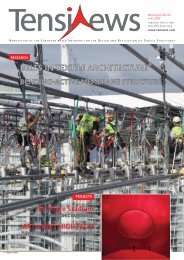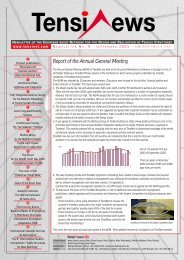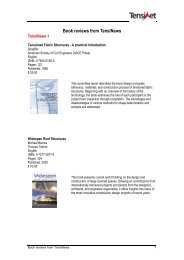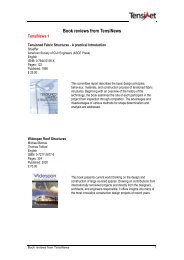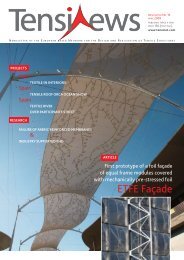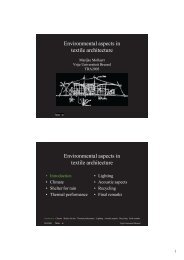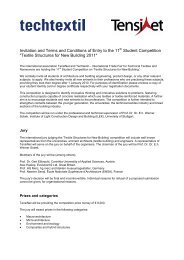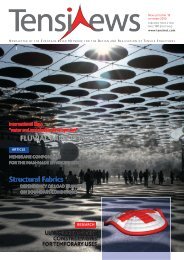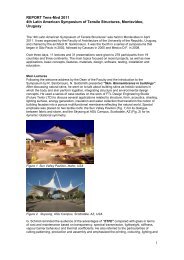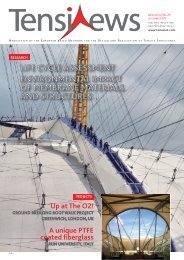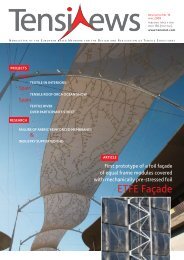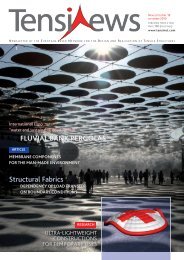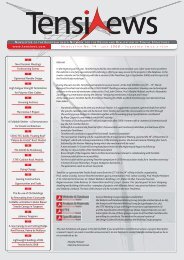Tensinews 21 - sept2011 - vers 31-8 - TensiNet
Tensinews 21 - sept2011 - vers 31-8 - TensiNet
Tensinews 21 - sept2011 - vers 31-8 - TensiNet
You also want an ePaper? Increase the reach of your titles
YUMPU automatically turns print PDFs into web optimized ePapers that Google loves.
For the installation the radial<br />
cables and ring cables are laid out<br />
in the stadium bowl. The open ends<br />
of the radial cables are fitted with<br />
temporary spreader bars to take on<br />
the lifting equipment. The upper<br />
radial cables are pulled towards the<br />
upper compression ring with strand<br />
jacks and pinned. This process will<br />
lift the cable net completely off<br />
the ground. Then the last 1.5m of<br />
the lower radial cables are pulled<br />
with the threaded bars and hollow<br />
hydraulic cylinders towards the<br />
lower compression ring until all<br />
cables can be pinned. This process<br />
is called the “big lift” and takes<br />
about 30 days.<br />
Membrane structure<br />
(Fig. 6 to Fig. 11)<br />
For the next installation step the<br />
membrane roof panels are fitted<br />
onto the completely stressed cable<br />
net. Each of the 80 bays consists of<br />
about 600m² PTFE/Glass mem -<br />
brane panels with an approximate<br />
weight of one tone. The membrane<br />
Installation of the membrane<br />
Figure 6. Beginning of membrane installation<br />
Figure 7. Roof view from below<br />
Figure 8. High point installation<br />
10 TENSINEWS NR. <strong>21</strong> – SEPTEMBER 2011<br />
fields will be cut from the virgin roll<br />
material, welded and assembled<br />
ready-to-install off site in the<br />
factory. They get packed, shipped to<br />
site and directly lifted onto the roof.<br />
The membranes are unfurled from<br />
the rolling rack on the lower<br />
compression ring. The membrane is<br />
then connected at the circular cut<br />
outs to the already positioned but<br />
lowered flying struts. The final<br />
shape and prestress is brought into<br />
the membrane by lifting the flying<br />
struts into their final position.<br />
This process is assisted by hydraulic<br />
jacks at the footing of the flying<br />
struts. The roof structure is<br />
completed after all the 640 light<br />
domes are mounted.<br />
! Gregor Grunwald<br />
: gregor.grunwald@<br />
hightexworld.com<br />
! Markus Seethaler<br />
markus.seethaler@<br />
hightexworld.com<br />
: www.hightexworld.com<br />
© Pictures: Hightex GmbH<br />
Name of the project: Olympic Stadium Kiev<br />
Location address: City of Kiev, Ukraine<br />
Client (investor): Olympic National Sports Complex, Ukraine<br />
Function of building: sport stadium<br />
Year of construction: 2010-11<br />
Architects: gmp • Architekten von Gerkan, Marg und Partner,<br />
Personal Creative Architectural Bureau Y. Serjogin<br />
Structural engineers: SBP – Schlaich Bergermann und Partner<br />
Manufacture and installation of cable net and membrane: Hightex GmbH<br />
Supplier of the membrane material: Verseidag-Indutex GmbH<br />
Material: PTFE-Glass<br />
Covered surface (roofed area): approx. 45.000m²<br />
6 7<br />
8<br />
10<br />
Figure 9. Roof top view<br />
Figure 10. Different stages of high point<br />
installation<br />
Figure 11. Installation of the high point<br />
clamping profile<br />
9<br />
11<br />
Anticlastic minimal<br />
surfaces as elements<br />
in architecture<br />
Introduction<br />
On the basis of the research of Frei Otto<br />
and his team at IL (Uni<strong>vers</strong>ity of Stuttgart)<br />
and the resulting exceptional pioneer<br />
constructions, building with textiles as an<br />
alternative to traditional materials like wood,<br />
stone, steel, glass, and concrete was<br />
rediscovered during the last decades.<br />
Deriving from self organizing forms of Minimal<br />
Surfaces, prestressed, spatially curved<br />
Membrane Structures were up to today<br />
mainly used for wide span, lightweightstructures.<br />
For this reason membrane<br />
structures tend to be seen from a<br />
structural or material point of view only.<br />
In contrast to our right-angled, conventionally<br />
built environment the desire for fluent<br />
“soft” spaces in architecture cannot be<br />
o<strong>vers</strong>een any more. The possibility to create<br />
light and fluent spaces as a symbiosis of<br />
form and structure offers new qualities<br />
and chances in the architectural design<br />
of residential or office buildings for example.<br />
Subject<br />
This article presents the overview of the<br />
research on spatially curved Minimal Surfaces<br />
that considers the infinite possibilities of<br />
membrane forms as elements in architecture<br />
in combination with common buildingtechnologies<br />
and shows new capabilities in<br />
designing and creating spaces. Seen as an<br />
element in the design of architecture these<br />
anticlastic, fluent forms caused by structural<br />
conditions, follow the rules of formfinding in<br />
its initially (by Frei Otto) defined sense.<br />
Very often we misuse the term „formfinding“.<br />
What Architects mostly mean and do is a man<br />
controlled process of shaping - a process that<br />
happens on a consciously controllable and<br />
formal level. In contrast to the mancontrolled<br />
process of shaping, forms that are<br />
arising from self organizing processes can only<br />
be influenced by the design of their<br />
boundaries. The form itself can only be found<br />
and represents the result which cannot be<br />
manipulated. The architect finds himself in the<br />
unusual position of a creative “formfinder”<br />
instead of the “shaper”.<br />
The fluent forms of Minimal-Surfaces are<br />
fascinating by their variety, structural<br />
performance, reduction to the minimal in<br />
terms of material use and resources and their<br />
special fashion-resistant aesthetics.




